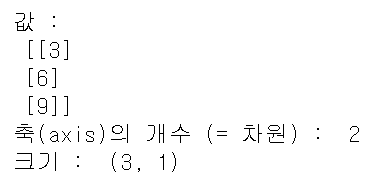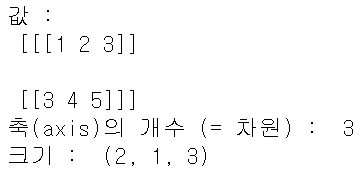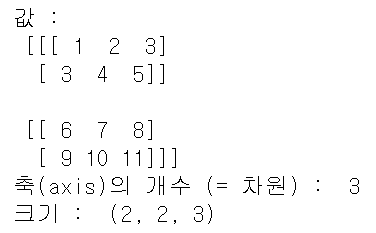[Numpy] 스칼라, 벡터, 행렬, 텐서 차이
2022. 12. 16. 16:06
import numpy as np스칼라 - 0D(demension, 차원) 텐서
크기만 갖고 있는 값
ex ) 1, 2, 3, ... , n
scalar = 3
zero_d_tenser = np.array(scalar)
print('값 : ', zero_d_tenser)
print('축(axis)의 개수 (= 차원) : ', zero_d_tenser.ndim)
print('크기 : ', zero_d_tenser.shape)
벡터 - 1D 텐서
크기와 방향을 갖는 1차원 값
(열,)
ex ) [ 1, 2, 3, ... , n ]
vec = [3, 6, 9]
one_d_tenser = np.array(vec)
print('값 : ', one_d_tenser)
print('축(axis)의 개수 (= 차원) : ', one_d_tenser.ndim)
print('크기 : ', one_d_tenser.shape)

위에 선언한 one_d_tenser는 3차원 벡터이자 1차원 텐서이다.
n차원 벡터 : 벡터 안 원소의 개수 (벡터에서의 차원)
n차원 텐서 : 축의 개수 (텐서에서의 차원)
행렬 - 2D 텐서
행과 열을 갖는 2차원 값
(행, 열)
ex ) [ [1, 2] , [3, 4], ... [n, m] ]
metrix= [[3], [6], [9]]
two_d_tenser = np.array(metrix)
print('값 : \n', two_d_tenser)
print('축(axis)의 개수 (= 차원) : ',two_d_tenser.ndim)
print('크기 : ', two_d_tenser.shape)
※ 주의 ※ 이전글 참고 : 넘파이 배열(np.array)
metrix= [[3], [6, 7], [9]]
two_d_tenser = np.array(metrix)
print('값 : \n', two_d_tenser)
print('축(axis)의 개수 (= 차원) : ',two_d_tenser.ndim)
print('크기 : ', two_d_tenser.shape)
텐서 - 3D 텐서
행과 열, 깊이를 갖는 3차원 값
(깊이, 행, 열)
ex ) [ [[1, 2]], [[3, 4]], ... , [[n,m] ]
tensor= [[[1, 2, 3]], [[3, 4, 5]]]
three_d_tenser = np.array(tensor)
print('값 : \n', three_d_tenser)
print('축(axis)의 개수 (= 차원) : ',three_d_tenser.ndim)
print('크기 : ', three_d_tenser.shape)
tensor= [[[1, 2, 3], [3, 4, 5]], [[6, 7, 8], [9, 10, 11]]]
three_d_tenser = np.array(tensor)
print('값 : \n', three_d_tenser)
print('축(axis)의 개수 (= 차원) : ',three_d_tenser.ndim)
print('크기 : ', three_d_tenser.shape)
'ML > Numpy' 카테고리의 다른 글
| [Numpy] argsort() 사용법 (0) | 2023.01.10 |
|---|---|
| [Numpy, Scipy] np.array, toarray() 차이 (0) | 2022.12.16 |
| [Numpy] 넘파이 배열(np.array) (0) | 2022.11.09 |